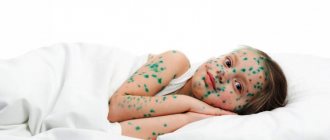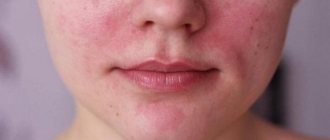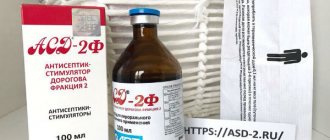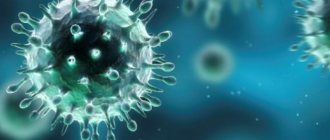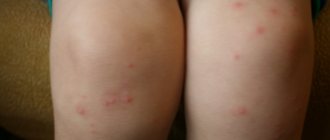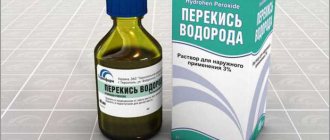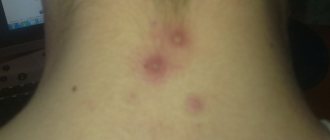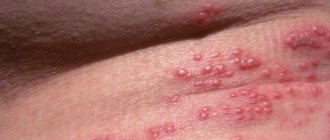Maculopapular rash is the body’s reaction to the presence of external or internal pathogenic factors that provoke the formation of purple or rich burgundy papules on the skin, rising above the general level of the skin. In fact, maculopapular rash is one of many types of dermatitis, which can have a different nature of origin. In a short period of time, the rash spreads completely throughout the body, covering more and more areas of epidermal tissue. The disease is always distinguished by an acute clinical picture with inflammation of the upper layer of the epithelium.
Causes
maculopapular rash in the photo
Skin rashes of the maculopapular type form for many reasons. A dermatologist, after an initial examination of the patient, depending on the location of the rash, is able to suspect the cause of the dermatological disease and refer the patient for a series of tests to confirm or refute the suspicion. Most often, maculopapular rashes are associated with functional disorders of human organs and systems . Basically, this is an infectious tissue damage caused by bacterial invasion of Staphylococcus aureus, streptococcal infection, mononucleosis, and the causative agent of scarlet fever.
Based on many years of medical practice, the following diseases are identified that cause maculopapular rash:
- sudden exanthema;
- enteroviral damage to the gastrointestinal tract;
- rubella;
- scarlet fever;
- measles;
- Infectious mononucleosis;
- adenoviral infection;
- erythema of infectious etiology.
Sometimes a dermatological rash on the body is provoked by diseases that were suffered previously, but a small number of pathogens remain in the human body, causing a chronic inflammatory process. When the immune system weakens, the source of bacterial infection becomes active, eventually leading to maculopapular rashes. In most cases, this reaction of the body is caused by the constant presence of Staphylococcus aureus and Streptococcus in the blood.
In people who have an individual tendency to exhibit allergic reactions, maculopapular rashes may be one of the types of allergy manifestations. The formation of allergic papules is especially often observed after treatment of infectious diseases with the use of potent antibacterial drugs of the penicillin series, sulfonamides and semi-synthetic penicillin. Each case of the formation of an extraneous rash in the form of papules is individual and requires a thorough diagnostic examination of the body.
Any medication that contains synthetic components can cause the patient to develop red spots and papules on the surface of the palms and in the armpits. Also, a negative reaction of the body may manifest itself in places of increased static load. As a rule, these are the lower and upper limbs directly involved in an active lifestyle.
A rash of the maculopapular type is not observed immediately after taking the drug, but only 3-5 days after taking the drug.
If it has been determined that the rash appears due to regular use of a certain type of drug, then treatment with this medication should be stopped immediately. Ignoring this warning risks the development of such severe complications as generalized erythroderma, as well as exfoliative dermatitis of the skin. In fact, these are particularly dangerous types of manifestation of a skin allergic reaction, accompanied by swelling of epithelial tissues, transformation of papules into wounds and ulcers, which constantly become wet, become crusty and heal poorly.
In addition to the above types of infections that provoke the appearance of a maculopapular rash, dermatological pathology can also occur due to the presence of diseases such as late-stage AIDS and type 2 diabetes mellitus. If the formation of purple papules is detected only on the skin surface of the buttocks, abdomen and groin area, then the dermatologist, after a preliminary examination of the patient, makes the assumption that the patient has secondary syphilis and directs the latter to donate blood from a vein in order to conduct the Wasserman reaction to identify the causative agent of this venereal infection.
Maculopapular
The macular type of rash is characterized by the formation of vesicles with a dense, pastel-colored consistency. Elements can appear on any part of the body, on the palms and soles.
Causes of unpleasant symptoms:
- infectious diseases - measles, mononucleosis, rubella;
- allergies to medications, waste products of staphylococcus, streptococcus provoke the appearance of papules;
- helminthic infestation - swellings on the skin can merge with each other;
- action of viruses, HIV infection.
After identifying a rash, consult a doctor for a comprehensive examination of the patient.
First symptoms of manifestation
Signs of a maculopapular rash appear almost simultaneously with the end of the incubation period of the infection that caused the skin lesions. In this case, the patient experiences the following symptoms:
- the skin rash is localized on the abdomen and quickly spreads from its surface to all parts of the body;
- the skin is very itchy and at the same time signs of infectious inflammation of the surface layer of the epithelium are observed;
- in some cases, if the disease is caused by a streptococcal infection, peeling of the epidermal tissues may occur with the formation of ulcers, which are very painful;
- the sebaceous glands behind the ears enlarge;
- inflammatory swelling of the submandibular, axillary and inguinal lymph nodes occurs, and during palpation they become painful;
- the rashes have a uniform appearance of round or oval pink papules, the diameter of which is no more than 1 centimeter with an elevation above the general skin level of 2-3 millimeters;
- depending on the type of bacterial pathogen, they can merge into a single inflammatory spot, develop into ulcerative formations, or change shade from light red to darker colors;
- As the underlying disease is treated, the dermatological manifestations fade, and the maculopapular rash becomes pale and gradually completely disappears from the surface of the body.
A characteristic feature of this type of rash is that they disappear as suddenly as they appeared. If the rash was not provoked by Staphylococcus aureus or streptococcal infection, then scars or cicatricial changes on the skin remain in principle.
Consumer Reviews
Angelina (otzovik.com)
“Girls, I’m sharing with you my huge discovery! I had very dry skin trying to get rid of pimples. Even foundation was scary to apply, because it emphasized all the peeling, of which there were a lot. I tried a cream for sensitive skin - everything went away. Within a week, the skin was very well nourished, but it did not become oily or anything else. I didn't notice any rashes either. So I'm happy :)"
Mane4ka10 (otzovik.com)
“Little children require appropriate care. Therefore, you always try to buy not only effective, but also safe drugs. So, when my son was very small, he developed a slight irritation on his body. The pharmacy recommended La-Cri cream.
As you can see on the label, its main functions are moisturizing, reducing redness and reducing itching. Exactly what I needed.
Everything is written in detail on the label, the composition is described in detail
When I opened it, I was a little surprised, because I expected to see a white cream without a smell or, on the contrary, with a pleasant aroma for children. However, in fact, what awaited me was a brown composition with a not very pleasant smell.
Although this is not the most important thing, the effect is much more important, and it turned out to be real. The irritation went away after a couple of uses. Now I often purchase this product, and I use it not only for my son, but for myself when necessary.”
Sources:
- Boniface Ernesto, Differential diagnosis in pediatric dermatology, publishing house: Panfilov Publishing House, Binom. Knowledge Laboratory, 2014
- Habiff Thomas P., Clinical Dermatology. Acne-like and papulosquamous dermatoses, publishing house: MEDpress-inform, 2014
- Churolinov Petr, Herbal medicine in dermatology and cosmetics, Medicine and Physical Education Publishing House, 1979
- Schneiderman Paul, Grossman Mark, Differential diagnosis in dermatology. Atlas, Publishing house: Binom, 2017
Photos of dermatitis
Photo album on the disease
Diagnostics
To make a final diagnosis and find out the reason why the patient has a rash, the dermatologist begins an examination, which consists of the following steps:
- Initial examination. The doctor studies the characterizing data of the papules, their appearance, volume, diameter and location. This will allow the doctor to put forward a theory about the presence of a particular disease, which initially became a provocateur of the dermatological illness. The type of further analyzes that will need to be carried out depends on this.
- Dermatoscopy. Using special medical equipment - a graphic dermatoscope, the doctor examines inflamed tumors in an enlarged mode, determining the depth and severity of damage to epidermal tissues.
- In the case of the presence of ulcerative formations and wound surfaces on the skin, which were formed under the influence of pathogenic activity of bacteria, smears of the mucous membrane of destroyed epithelial tissue are taken. This is necessary to determine the type of infectious pathogen in order to select the most effective type of antibacterial drug.
- Blood donation. Venous blood sampling is a prerequisite to exclude the presence of severe infections in the patient such as AIDS, hepatitis, secondary syphilis, and anthrax. All these diseases tend to provoke the appearance of a maculopapular rash, which literally covers the patient’s body with one single inflammatory spot in just a few days.
Depending on the development of the clinical picture of a dermatological disease, the attending physician may decide to prescribe additional tests, the choice of which is determined solely by him, as a specialist in the field of dermatology.
Maculopapular
The rashes are small in size - from 1 to 10 mm and the nature of their location on the skin. They are localized on the face, spread throughout the body, and have pink and brown shades.
Causes of macular papular rashes:
- measles is a disease accompanied by high fever. Gradually a fusion of elements occurs;
- entero- and rotavirus – bulges appear on the face and move to the body;
- papular urticaria - an allergic reaction that causes itching, rash - medium-sized blisters;
- exudative form of erythema - attributes are localized on the flexor surfaces;
- mononucleosis - formations on the skin up to 1.5 cm of irregular proportions;
- chickenpox, scarlet fever, meningitis, felinitis - are accompanied by the appearance of growths that go through the stages of development from papule to vesicle, expulsion of the contents of the capsule, healing of the wound;
- syphilis - a rash forms in the second stage of the disease, the appearance of nodules is accompanied by severe itching. The elements are red, brown, localized on the neck, upper body, and head. The temperature does not increase during the secondary stage of the disease;
- rubella - the elements are small, point-like, and do not merge.
How is maculopapular rash treated?
Therapy for this dermatological pathology is based on the treatment of the primary disease, which caused the appearance of rashes on the surface of the epithelium. Therefore, there is not yet and cannot be a universal and unified treatment protocol due to the individual nature of the course of the disease. After a papular rash appears on the skin surface, a person should immediately visit a dermatologist. The specialist will conduct an examination, prescribe tests and, having received comprehensive information about the disease, will select medications that will be effective specifically in this case.
If the cause of the formation of a rash of the maculopapular type is a bacterial invasion of the body that has spread to the epidermal tissues, then in most cases the following types of medications are used:
- Zyrtec;
- Suprastin;
- Zodak;
- Erius.
These medications block the possible manifestation of an allergic reaction, eliminate itching and swelling of the skin, relieve inflammation and suppress the activity of pathogenic infection. If the skin is dry, then use the medications Bepanten, La-kri, Psilo-balm. These medications also help relieve itching and other discomfort. For extensive lesions of the epithelium with partial destruction of its surface, a dermatologist can use corticosteroid drugs in the form of Prednisolone and Dexamethasone in treatment. It is recommended to stop taking these medications in tablets and administer hormonal substances intravenously. This way it will be possible to achieve the maximum therapeutic effect in a short period of time.
Prevention
The main method of preventing the disease is maintaining personal cleanliness and sanitation rules when visiting public places, contacting animals and other people. It is necessary that personal hygiene items, shoes and underwear are not used by other people and never take someone else’s.
It is necessary to keep the body, personal belongings and housing clean. This is enough for better prevention of various rashes and skin damage.
Understanding the full danger of diseases, the manifestation of which is a papular rash, and awareness of the need to immediately contact a medical facility is the key to a correct diagnosis and quick recovery. Treatment at home can lead to very serious consequences.
What hurts with coronavirus: bones or muscles?
We can definitely say that it is both. The most amazing feature of the coronavirus is that on the surface of its receptors it carries a specific protein ACE2, to which there are authentic proteins in the cells of blood vessels and nerves, that is, in almost all tissues of the body. Most of the ACE2 proteins are in the nasopharynx, which is why the infection begins there. But such cells exist in joint and muscle tissues.
The initial increase in temperature is intended to help the immune system and make it more difficult for the coronavirus to attach to cells. At the same time, the body gets rid of dead growths: at this moment, pain appears in the bones, as they produce more white blood cells to fight viruses. After them, myocytes are involved in the process: the blood supply is redistributed, the muscles suffer from lack of nutrition and oxygen.
Before being removed from the body, dead cells manage to poison it. SARS-CoV-2 begins to affect vascular myocytes that regulate blood pressure. Pain sensations become diffuse. The lack of clear localization of pain makes it impossible to determine its source.
What are “Covid toes”?
This skin symptom of coronavirus is expressed by redness and swelling of one or more toes, less commonly, hands; the phalanges may look as if they are frostbitten. The fingers may also take on a violet-purple hue. The change in skin color may start from red and gradually turn purple, but it is also possible to suddenly acquire a purple tint.
Along with swelling and discoloration, the patient's toes may become blistered, itchy, or painful. Some people also develop painful bumps or patches of rough skin.
Experts note that such manifestations of COVID-19 are not always accompanied by other, more familiar symptoms of the disease.
Feeling body aches when infected with Covid
Body aches during coronavirus infection can be classified as symptoms of the prodromal period (incubation). A person’s sensations are reduced to moderate pain in the arms and legs, the whole body, which reduces performance and quality of life. Such symptoms are characteristic of degeneration of the musculoskeletal system or autoimmune pathology. With coronavirus, this is due to the gradual introduction of the microbe into the cells of the nervous and immune systems.
All viruses have one thing in common - they are carriers of a certain DNA or RNA. In the case of coronavirus, this is RNA. When COVID-19 enters cells, and it cannot live extracellularly, it completely illogically begins to destroy its habitat. An immune response occurs and the main symptoms of the disease appear.
There is no clear localization in this condition; sometimes the aches are accompanied by low-grade fever, and sometimes they do without it. A person infected with coronavirus describes his condition as some kind of twisting of joints, squeezing muscle pain, and a sensation of flattening of bones. Coronavirus is accompanied by symptoms of chronic fatigue, fatigue, increased nervousness, and apathy. If the aches transform into severe diffuse pain, they speak of a poor prognosis for the development of the disease: you should consult a doctor.
The effect of coronavirus on the nervous system
Relatively recent studies show that coronavirus can also infect the central nervous system. If early analyzes of patients with COVID-2019 in January described mainly fever, cough, and hypoxemia, then later they began to be joined by other symptoms in the form of vomiting and diarrhea.
More to come... Scientists have begun to notice the impact of coronavirus on the nervous system in general and the brain in particular. This was the first time there was a neurological manifestation of the disease, which was the center of the pandemic in February
The retrospective study states that of the 214 patients with COVID-2019 examined, 78 had symptoms from the central nervous system, and another 19 from the peripheral nervous system. The most common complaints were:
- Strong headache;
- myasthenia gravis (severe muscle weakness);
- dizziness;
- hypogeusia (dullness of taste);
- hyposmia (decreased sense of smell).
It sounds frivolous at first glance, however, coronaviruses tend to “spread along a synaptically connected pathway to the medullary cardiorespiratory center from mechanoreceptors and chemoreceptors in the lungs and lower respiratory tract.”
It remains unclear whether SARS-CoV-2 attacks the brain directly, as in the case of the lungs, or whether this is an indirect result due to poor oxygen supply to the central nervous system. There is a hypothesis that the coronavirus still affects the nervous system and thus provokes respiratory failure.
Among the neurological complications of COVID-2019 is chills, which persists even after the coronavirus has completely disappeared from the body.
Cases of encephalopathy in patients with neurological diseases are also described. A 74-year-old man with a history of Parkinson's disease lost the ability to speak after being diagnosed with COVID-2019.
The mechanism by which the SARC-CoV-2 coronavirus can enter the brain is currently unknown. However, experience with other viruses (such as the influenza virus) tells scientists that it is certainly capable of this.
